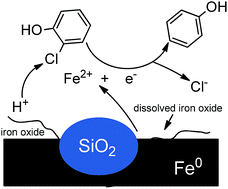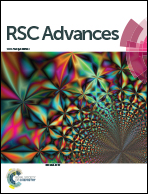A mechanically synthesized SiO2–Fe metal matrix composite for effective dechlorination of aqueous 2-chlorophenol: the optimum of the preparation conditions
Abstract
In this study, abrasives-reinforced metal matrix composites (MMCs) with a microscale size synthesized by ball milling (BM) could achieve highly active and stable dechlorination efficiency for aqueous 2-chlorophenol (2-CP). The preparation process of this composite via BM was optimized to obtain a high degradation efficiency, especially for the effect of the abrasives including B4C, SiC, α-Al2O3, SiO2, Fe3O4 and Na2SO4. The results showed that the hardness of the abrasives in the Fe-based MMCs was closely related with their dechlorination performance. Subsequently, the optimal abrasive, i.e. SiO2 was further investigated for its proper milling conditions with zero-valent iron (ZVI) particles including optimal SiO2 size, SiO2 loading, milling time, and the dosage of the process control agent (PCA). Additionally, the influence of other metal categories including Al and Si was also investigated for dechlorination; and their low reaction efficiencies were closely related with their passivating film. Finally, the longevity test suggested that the decreased reactivity of the SiO2–Fe MMC during the storage in air could be recovered when consecutively used, mainly due to the promoting effects of the inherent structure of SiO2–Fe MMC with the Fe/C and Fe/SiO2 interfaces, as well as the effective regeneration of the reactive sites by continuous iron dissolution.


 Please wait while we load your content...
Please wait while we load your content...